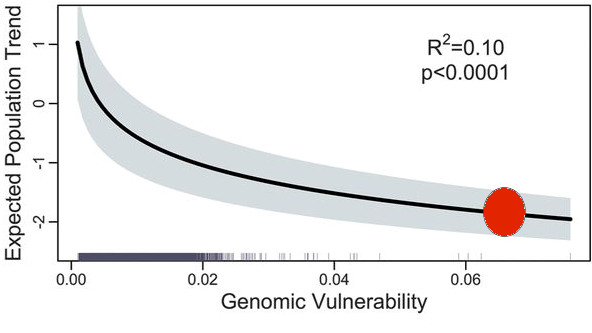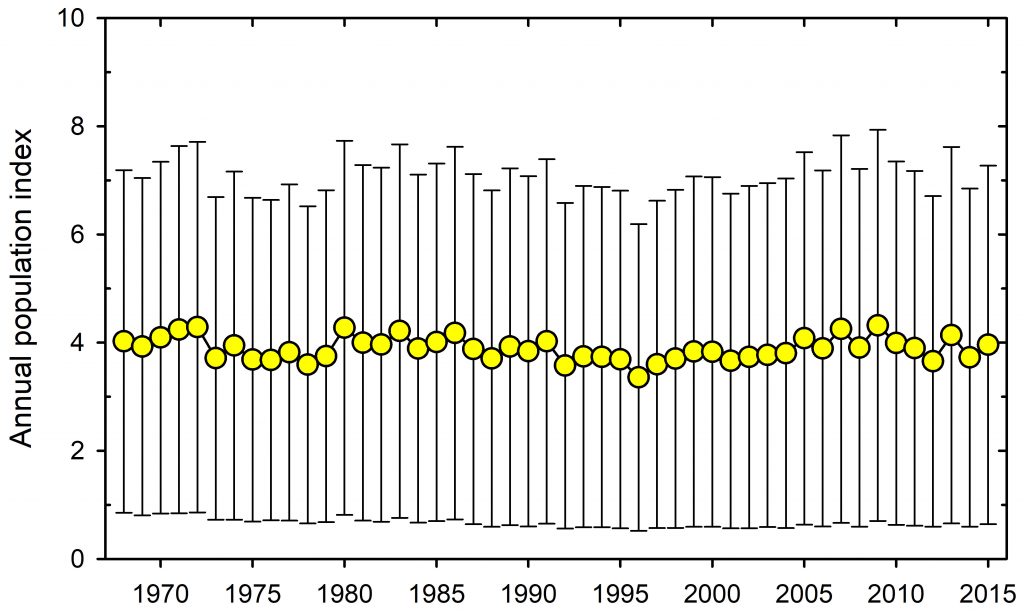If ecology can team up with evolution to become a predictive science, we can all profit greatly since it will make us more like physics and the hard sciences. It is highly desirable to have a grand vision of accomplishing this, but there could be a few roadblocks on the way. A recent paper by Bay et al. (2018) illustrates some of the difficulties we face.
The yellow warbler (Setophaga petechia) has a broad breeding range across the United States and Canada, and could therefore be a good species to survey because it inhabits widely different climatic zones. Bay et al. (2018) identified genomic variation associated with climate across the breeding range of this migratory songbird, and concluded that populations requiring the greatest shifts in allele frequencies to keep pace with future climate change have experienced the largest population declines, suggesting that failure to adapt may have already negatively affected population abundance. This study by Bay et al. (2018) sampled 229 yellow warblers from 21 locations across North America, with an average of 10 birds per sample area (range n = 6 to 21). They examined 104,711 single-nucleotide polymorphisms. They correlated genetic structure to 19 climate variables and 3 vegetation indices, a measure of surface moisture, and average elevation. This is an important study claiming to support an important conclusion, and consequently it is also important to break it down into the three major assumptions on which it rests.
First, this study is a space for time analysis, a subject of much discussion already in plant ecology (e.g. Pickett 1989, Blois et al. 2013). It is an untested assumption that you can substitute space for time in analyzing for future evolutionary changes.
Second, the conclusions of the Bay et al. paper rest on an assumption that you have adequate data on the genetics involved in change and on the demography of the species. A clear understanding of the ecology of the species and what limits its distribution and abundance would seem to be prerequisites for understanding the mechanisms of how evolutionary changes might occur.
The third assumption is that, if there is a correlation between the genetic measures and the climate or vegetation indices, one can identify the precise ‘genomic vulnerability’ of the local population. Genomic variation was most closely related to precipitation variables at each site. The geographic area with one of the highest scores in genomic vulnerability was in the desert area of the intermountain west (USA). As far as I can determine from their Figure 1, there was only one sampling site in this whole area of the intermountain west. Finally Bay et al. (2018) compared the genomic vulnerability data to the population changes reported for each site. Population changes for each sampled site were obtained from the North American Breeding Bird Survey data from 1996 to 2012.
The genetic data and its analysis are more impressive, and since I am not a genetics expert I will simply give it a A grade for genetics. It is the ecology that worries me. I doubt that the North American Breeding Bird Survey is a very precise measure of population changes in any particular area. But following the Bay et al. paper, assume that it is a good measure of changing abundance for the yellow warbler. From the Bay et al. paper abstract we see this prediction:
“Populations requiring the greatest shifts in allele frequencies to keep pace with future climate change have experienced the largest population declines, suggesting that failure to adapt may have already negatively affected populations.”
The prediction is illustrated in Figure 1 below from the Bay et al. paper.
 Figure 1. From Bay et al. (2018) Figure 2C. (Red dot explained below).
Figure 1. From Bay et al. (2018) Figure 2C. (Red dot explained below).
Consider a single case, the Great Basin, area S09 of the Sauer et al. (2017) breeding bird surveys. From the map in Bay et al. (2018) Figure 2 we get the prediction of a very high genomic vulnerability (above 0.06, approximate red dot in Figure 1 above) for the Great Basin, and thus a strongly declining population trend. But if we go to the Sauer et al. (2017) database, we get this result for the Great Basin (Figure 2 here), a completely stable yellow warbler population for the last 45 years.
Figure 2. Data for the Great Basin populations of the Yellow Warbler from the North American Breeding Bird Survey, 1967 to 2015 (area S09). (From Sauer et al. 2017)
One clue to this discrepancy is shown in Figure 1 above where R2 = 0.10, which is to say the predictability of this genomic model is near zero.
So where does this leave us? We have what appears to be an A grade genetic analysis coupled with a D- grade ecological model in which explanations are not based on any mechanism of population dynamics, so that the model presented is useless for any predictions that can be tested in the next 10-20 years. I am far from convinced that this is a useful exercise. It would be a good paper for a graduate seminar discussion. Marvelous genetics, very poor ecology.
And as a footnote I note that mammalian ecologists have already taken a different but more insightful approach to this whole problem of climate-driven adaptation (Boutin and Lane 2014).
Bay, R.A., Harrigan, R.J., Underwood, V.L., Gibbs, H.L., Smith, T.B., and Ruegg, K. 2018. Genomic signals of selection predict climate-driven population declines in a migratory bird. Science 359(6371): 83-86. doi: 10.1126/science.aan4380.
Blois, J.L., Williams, J.W., Fitzpatrick, M.C., Jackson, S.T., and Ferrier, S. 2013. Space can substitute for time in predicting climate-change effects on biodiversity. Proceedings of the National Academy of Sciences 110(23): 9374-9379. doi: 10.1073/pnas.1220228110.
Boutin, S., and Lane, J.E. 2014. Climate change and mammals: evolutionary versus plastic responses. Evolutionary Applications 7(1): 29-41. doi: 10.1111/eva.12121.
Pickett, S.T.A. 1989. Space-for-Time substitution as an alternative to long-term studies. In Long-Term Studies in Ecology: Approaches and Alternatives. Edited by G.E. Likens. Springer New York, New York, NY. pp. 110-135.
Sauer, J.R., Niven, D.K., Hines, J.E., D. J. Ziolkowski, J., Pardieck, K.L., and Fallon, J.E. 2017. The North American Breeding Bird Survey, Results and Analysis 1966 – 2015. USGS Patuxent Wildlife Research Center, Laurel, MD. https://www.mbr-pwrc.usgs.gov/bbs/

Given the contrast between the excellent genetic analysis and the poor ecological model, how can future research better integrate genetics and ecology to create more predictive and testable models for climate-driven adaptation? discuss with us
Alas this is a complicated problem. First off, I would begin with the assumption that climate changes in population size for any species must be driven by ecological variables – temperature, rainfall, new predators, disease – that is to say you should first have a good grasp of population dynamics for the species of concern. The problem is that this is very difficult and requires long term research. The world wants answers quickly so it moved to the easier option of genetic changes. I would presume if you did a long term (multi-generation) study of any species you would find genetic changes even if you had a constant climate. The problem then is one of mechanism – what is producing changes in physiology, body weight, reproductive outlay, etc – which explains the ecological issue. Given that there are a very large number of nucleotides or “genes” that you can now sequence, you face the statistical dilemma of one ecological effect vs thousands of possible genetic variables. With enough variables any statistician will tell you that it is certain to find some correlations. But correlation is not causation, and much detailed genetic-physiological-ecological work must be done to confirm mechanisms. But given the short term thinking of today, you could find some good genetic variation to “determine” = correlate with population declines. There are very few examples of genetics for the explanation of population declines. If you back off the ecology and use “adaptation” you have another large pool of “adaptation” variables, and again some correlations will pop out. “Genetics explains everything” is the mantra of our day, but the explanations as of today are largely unknown because if some adaptation occurs, many gene to gene interactions will be involves. Very complex problems and now often simple pushed solutions. Read “Tyranny of the Gene” by James Tabery, Alfred Knopf, 2023, ISBN 9780525658214 for a human analogy. So in short, if you are concerned in any species about climatic adaptation, find out first what parts of demography are involved and affected by changing climate, whether the cause of the problem is ecological, and try to understand the ecology of the adaptative. Then and if you have much time and very much money start on the genetics of the problem, and by that time the species will be extinct. Read the coral reef literature, hot water = coral deaths but solve the hot water problem rather than spending all your time on the genes affecting water temperature tolerance in corals.
How can future studies improve the integration of genetic analysis and ecological modeling to create more accurate predictions about species adaptation to climate change?
You ask a most difficult question. First you need more good reliable monitoring of species populations and the physiological and behavioural measures of their changes over time. This requires a time frame which under current funding (short term) is difficult. The changes that are genetic and/or physiological need to be recorded for possibly more years than a research scientist lives, so we need long term thinking on this issue. It may be relatively easy with organisms like corals but it gets much more difficult when you move to the higher vertebrates. Secondly you need climate change measurements that are relevant to the species’ life cycle, be it temperature in the water or in the soil or whatever the ecology presents. At present our ecological modelling about this proposal are in the stone age from lack of relevant data over a sufficient time scale. Climate change must be specified rather than be vague, ? temperature data, water balance data, winter adaptations, etc. To me the major limiting factor is long-term planning and getting long term funding. Ecologists in general are all over the map in their research interests so there is no coherent plan equivalent to the sort of plan that comes out of SARS epidemics, or getting to the moon. So we need ecological champions with a vision and a good system/species to follow, coordinated with the real world monitoring data that are relevant. We perhaps think too much that big changes will occur in a few years of a 5 year research grant, and this is most unlikely. So think long term, work long term, and no not get discouraged if you do not get the Nobel Prize.